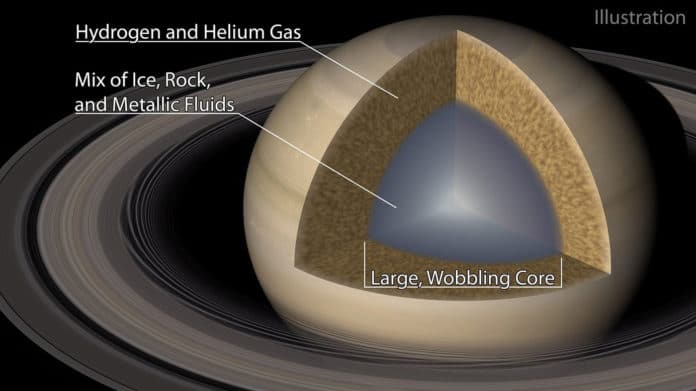A new study found that oscillations in Saturn’s interior make the gas giant jiggle around ever so slightly. These motions, hence, cause ripples in Saturn’s rings. The outcome of the study offers the best evidence yet for Saturn’s fuzzy core.
Scientists a Caltech studied the ripples in Saturn’s rings to know more about Saturn’s core. For this study, they used old data from NASA’s Cassini spacecraft. They found that the core of the ringed planet is not a hardball of rock, instead of a diffuse soup of ice, rock, and metallic fluids.
Their analysis also reveals that the core extends across 60 percent of the planet’s diameter, making it substantially larger than previously estimated.
In this study, scientists used Saturn’s rings like a giant seismograph to measure oscillations inside the planet. This is the first time scientists could seismically probe the structure of a gas giant planet.
Jennifer Jackson, the William E. Leonhard Professor of Mineral Physics in the Seismological Laboratory at Caltech, said, “The detailed analysis of Saturn‘s rippling rings is an exquisite form of seismology to infer the characteristics of Saturn’s core.”
Christopher Malkovich, a lead author of the study, said, “The fuzzy cores are like a sludge. The planet’s hydrogen and helium gas gradually mix with more ice and rock as you move toward the planet’s center. It’s a bit like parts of Earth’s oceans where the saltiness increases as you get to deeper and deeper levels, creating a stable configuration.”
After analyzing the wave pattern of the rings, scientists built a new model of Saturn’s sloshing interior. The model shows that the deep interior of Saturn is composed of stable layers that formed after heavier materials sunk to the middle of the planet. It also stopped mixing with lighter materials above them.
Co-author Jim Fuller, assistant professor of theoretical astrophysics at Caltech, said, “For the planet’s gravitational field to be oscillating with these particular frequencies, the interior must be stable, and that’s only possible if the fraction of ice and rock gradually increases as you go in toward the planet’s center.”
“The results also indicate that the core of Saturn is 55 times as massive as the entire Earth, with 17 Earth-masses of that being ice and rock and the rest a fluid of hydrogen and helium.”
Hedman, who is not part of the current study, says, “Christopher and Jim were able to show that one particular ring feature provided strong evidence that Saturn’s core is extremely diffuse. I am excited to think about what all the other ring features generated by Saturn might be able to tell us about that planet.”
Journal Reference:
- Mankovich, C.R., Fuller, J. A diffuse core in Saturn was revealed by ring seismology. Nat Astron (2021). DOI: 10.1038/s41550-021-01448-3
